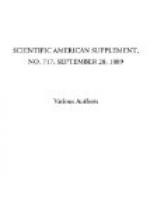[Footnote 2: Dr. Lodge
has been able, by an elaborate
arrangement of screens, to
make this attraction just evident to
an audience.—C.
V. B.]
Now I have in a hole in the wall an instrument no bigger than a galvanometer, of which a model is on the table. The balls of the Cavendish apparatus, weighing several hundredweight each, are replaced by balls weighing 13/4 pounds only. The smaller balls of 13/4 pounds are replaced by little weights of 15 grains each. The 6 foot beam is replaced by one that will swing round freely in a tube three-quarters of an inch in diameter. The beam is, of course, suspended by a quartz fiber. With this microscopic apparatus, not only is the very feeble attraction observable, but I can actually obtain an effect eighteen times as great as that given by the apparatus of Cavendish, and what is more important, the accuracy of observation is enormously increased.
The light from a lamp passes through a telescope lens, and falls on the mirror of the instrument. It is reflected back to the table, and thence by a fixed mirror to the scale on the wall, where it comes to a focus. If the mirror on the table were plane, the whole movement of the light would be only about eight inches, but the mirror is convex, and this magnifies the motion nearly eight times. At the present moment the attracting weights are in one extreme position, and the line of light is quiet. I will now move them to the other position, and you will see the result—the light slowly begins to move, and slowly increases in movement. In forty seconds it will have acquired its highest velocity, and in forty more it will have stopped at 5 feet 81/2 inches from the starting point, after which it will slowly move back again, oscillating about its new position of rest.
It is not possible at this hour to enter into any calculations; I will only say that the motion you have seen is the effect of a force of less than one ten-millionth of the weight of a grain, and that with this apparatus I can detect a force two thousand times smaller still. There would be no difficulty even in showing the attraction between two No. 5 shot.
And now, in conclusion, I would only say that if there is anything that is good in the experiments to which I have this evening directed your attention, experiments conducted largely with sticks, and string, and straw and sealing wax, I may perhaps be pardoned if I express my conviction that in these days we are too apt to depart from the simple ways of our fathers, and instead of following them, to fall down and worship the brazen image which the instrument maker hath set up.




